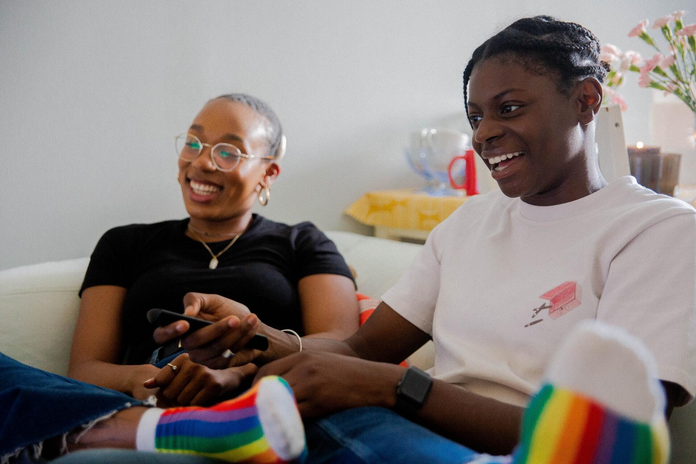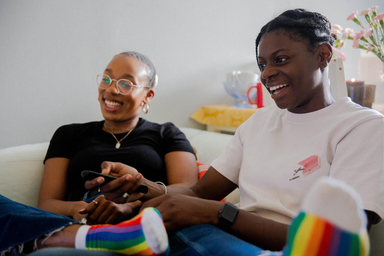Stereotypes, sexualization, lack of development, toxic relationships and misrepresentations. That’s what we frequently see in movies, TV series and books that portray LGBTQ characters.
Since June is the Pride Month, we gathered opinions from people in the community about characters that harmed them instead of making them feel represented.
- Elio and Oliver, from “Call Me By Your Name”
-
The journalism student Catharina Pinheiro, 17, believes that the couple from the book and movie “Call Me By Your Name” has a problematic behavior. Elio is an underage boy and Oliver is way older than him, and the author André Aciman writes them as an ideal and romantic relationship. He doesn’t point it out as something inappropriate or show the readers how wrong it is for a minor to be manipulated by someone older. For her, “the story is basically about pedophilia and it reinforces the stereotype that homosexuals are pedophiles”.
Also about the stereotypes, Catharina mentions that the book is full of them since the author is straight and doesn’t know a thing about gay couples. “He should have at least done a research about it, but it doesn’t look like he did it”. She says that he considered stereotypes that heterosexuals and homophobes have about LGBTs and wrote a book based on them. And, to make everything worse, she mentions that he finds the couple beautiful since one of them doesn’t know much about life and the other has a lot to teach.
Besides, Catharina thinks Elio is obsessed with Oliver and expected that this obsession would be something criticized in the book, but it was romanticized instead. There is a specific scene that she finds disturbing: when the boy goes hidden to the older man’s room, gets one of his shorts and masturbates while wearing it.
At the end of the book, after spending the summer with Elio, Oliver leaves him and goes back to his girlfriend. She thinks that this adds up to another stereotype: that being homosexual is a lifestyle or a phase that you can drop at any time and go back to dating the opposite gender when the fun is over. That was traumatic for the younger one, “when the boy narrates the story, years later, he seems to be telling a trauma and abuse more than a loving relationship. He describes it with pain, agonizing over the memories”.
- Adèle and Emma, from “Blue Is the Warmest Color”
-
The movie about Adèle, who is still in high school, and Emma, an arts undergraduate, is very problematic for the journalism students Júlia Bonin, 19, and Maria Clara Villela, 18. The couple from the movie met while seeing other people and soon split out to date each other. Later, when they are living together and Adèle is working as a teacher, she starts cheating on Emma with one of her colleagues at work and the other girl does the same with one of her exes.
When Emma finds out that she’s also being cheated on, she does an “unnecessary terror”, as said by Júlia, and kicks Adèle out of their home, making her completely psychologically destroyed. For Júlia, the movie focuses only on the bad parts of the relation, while the good ones from the beginning are forgotten.
Maria Clara believes that, instead of exploring the sapphic romance, the producers fetishized them. “It really looks like a pornographic movie, because of the sexualization and all the making out”. She also mentions that one of the many sex scenes lasts seven minutes and the actors were forced by the director Abdellatif Kechiche to work on those scenes for many hours. And, for her, all the cheating they do can make the audience believe that women aren’t reliable when it comes to dating.
Júlia thinks that the production follows a heteronormative stereotype, since Emma is treated like the “man” in the couple, she provides the money, takes the leadership and decides everything. While Adèle is seen as inferior, as the housewife who cooks and cleans while the other one enjoys life.
The film is from 2013, when lesbians didn’t have much space in cinema and Júlia sees the visibility given by it as absolutely useless. “If we are supposed to have such a bad representation, I prefer not to have any because it did a huge disservice”.
- Simon Spier, from “Love, Simon”
-
For the economics student João Pedro Marconde, 18, the movie “Love, Simon” is controversial because it’s praised by its mostly straight audience. Simon is young, has a comfortable life, a liberal family, an almost perfect group of friends and “everything makes it like a classic rom-com movie, but it doesn’t deal with the important matters for an urgent movie like this”. For him, this can be important for normalizing different movies styles with the LGBT thematic. However, not addressing questions such as the violence, discrimination, stereotypes and social vulnerability “creates a fairy tale atmosphere”.
João Pedro concludes that when the public doesn’t see those problems, they don’t try to learn more about them, they don’t need to compromise and open their minds about those matters. And that is why he believes the movie is made specially for heterosexuals, who don’t relate to the situations and only see the perfect environment as enough.
- Levi and Nico, from “Grey’s Anatomy”
-
The couple from the hit series “Grey’s Anatomy” is also controversial for João Pedro. He feels that Levi Schmitt and Nico Kim have their representation and potential erased because of a shallow development. Despite bringing awareness to relevant issues, like religion and ancestry, since Levi is Jewish and the other one has a Korean family, “there’s an excessive sexualization that decreases the power they have from those super important issues”.
He adds that the relation turns out being toxic sometimes, because Nico represses Levi many times and doesn’t decide if he wants to date or just have a sex partner.
- Izzie, from “Atypical”
-
Izzie is a character from the Netflix’s series “Atypical” that starts dating Casey Gardner on the second season and, for the high school senior Ana Clara Binello, 17, the way the couple was included in the series wasn’t natural, it was a forced representation. When they started seeing each other, Casey was in a healthy relationship with someone else from the beginning and Izzie didn’t know if she really wanted to be in a relationship. “They went on and off, Izzie treated her badly and it became something exhausting”.
At some point, Izzie made out with a boy in front of the other girl and Ana Clara believes that this attitude can make people accept the stereotype that, if you date a bisexual person, you’ll always be replaced by someone from the opposite gender. “People kind of have this settled in their minds, and I think the producers even brought it unintentionally”.
The student also said that the couple isn’t a good representation for the LGBTQ community. For her, it is just something unhealthy and for people to get attached to.
—————————————————————
The article above was edited by Karen Oliveira.
Liked this type of content? Check Her Campus Casper Libero for more!


